Electronics ABC
Capacitors, Part 1 The Basics of Capacitors

Along with resistors and inductors, capacitors make up one of the three major categories of passive components. As many as about two trillion of these devices are being manufactured each year worldwide. The most common type is the ceramic capacitor, but there are many other kinds as well, such as film capacitors offering excellent insulation and stability, and electrolytic capacitors boasting large capacitance values. Different types are used in different ways, to make optimum use of their respective properties and features.
- Key Takeaways

- Operation principle and basic construction of capacitors

- Basic properties of a capacitor (1): "accumulates electric charge"

- Basic properties of a capacitor (2): "blocks DC, passes AC"

- Basic properties of a capacitor (3): "the higher the frequency, or the higher the capacitance, the more easily current can pass"

- Conclusion

- FAQ

Key Takeaways
1. Capacitor basics: A capacitor stores charge between two plates separated by a dielectric material.
2. Charging behavior: It charges until the voltage across its plates equals the source voltage, then holds that charge.
3. AC vs. DC behavior: It blocks DC current but passes AC due to displacement current created by field reversals.
4. Frequency dependence: Higher frequency or larger capacitance lowers reactance (Xc), allowing easier AC flow.
5. Common types: Ceramic (general purpose), film (stable), and electrolytic (high capacitance for power applications).
Operation principle and basic construction of capacitors
The basic form of a capacitor is two electrodes (metal plates) facing each other, with a gap in between. When a DC voltage (V) is applied to the two electrodes, electrons will instantly collect on one side, causing that electrode to have a negative charge, while electrons on the other electrode will be lacking, which means that it has a positive charge. This condition will remain also when the DC voltage is removed. In other words, an electric charge (Q) has now accumulated between the two electrodes. When a so-called dielectric (made of a ceramic material, plastic film, etc.) is inserted between the two electrodes, the dielectric polarization effect results in a higher charge. A numeric value expressing how much charge a capacitor can hold is called the electrostatic capacity, or capacitance (C) for short.

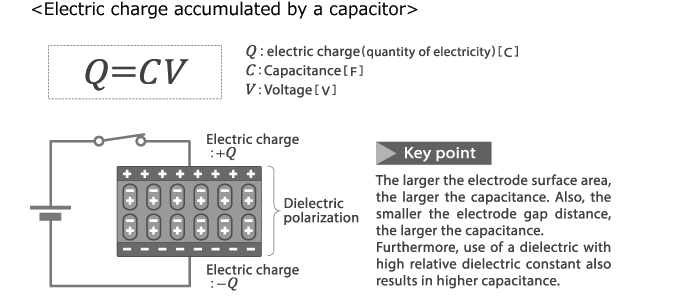
Basic properties of a capacitor (1): "accumulates electric charge"
A capacitor, as its name implies, is capable of storing a fairly large electrical charge, provided that its construction allows a large electrode surface area, and a dielectric with suitably high dielectric constant is used. When a DC voltage is applied directly from a power source, a current will momentarily flow in the conductor. As soon as the electric potential difference between the electrodes is equal to the power source voltage, the current stops and the charging process ends, meaning that the capacitor is charged. The charge and discharge processes are illustrated in the graph below.
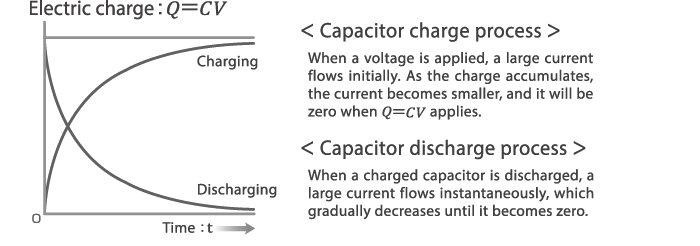
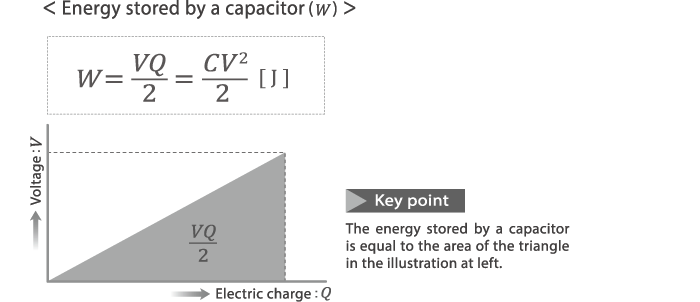
Basic properties of a capacitor (2): "blocks DC, passes AC"
Because the electrodes of a capacitor are separated by the dielectric, a current will flow momentarily in the conductor during the charging process, but the current will not actually pass through the dielectric inside the capacitor. In other words, the capacitor blocks the flow of direct current (DC). By contrast, when an alternating current (AC) power source is connected, the electrodes will alternately repeat a charge and discharge cycle, with the orientation of the electric field being reversed each time. Although there is no actual movement of electrons within the insulator, the effect is the same as if an AC current were flowing. Therefore a capacitor is regarded as passing AC current. Since it differs from regular conduction current, this type of current is called displacement current.
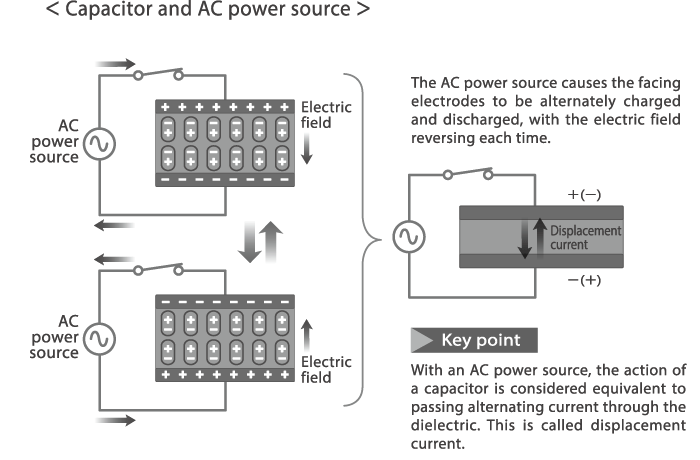
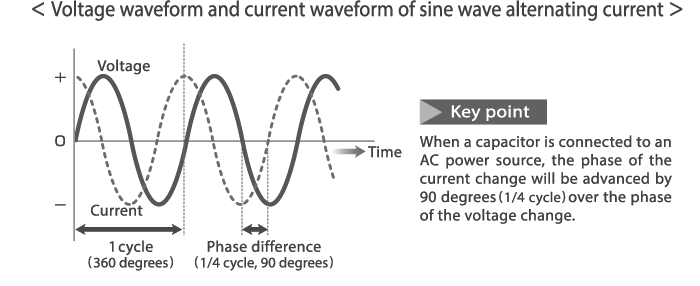
Basic properties of a capacitor (3): "the higher the frequency, or the higher the capacitance, the more easily current can pass"
As we have seen, one of the basic properties of a capacitor is that it blocks DC and passes AC. However, the ability to pass current is not the same for every kind of current. It depends on the frequency of the alternating current, as well as on the capacitance of the capacitor. The degree to which current can pass easily is indicated by a quantity called capacitive reactance(XC)This is the resistance of the capacitor to alternating current, and it is expressed in ohms [Ω]. The equation for the capacitive reactance (XC) of a capacitor is shown below.


Conclusion
Capacitors are simple in structure yet central to modern electronics: two plates, a dielectric, and predictable behavior. They store energy, block DC, couple AC, and shape signals, with Xc tying performance to frequency and capacitance. Practical design depends on selecting the right type and geometry, balancing size, stability, ESR, voltage rating, and cost to deliver the needed capacitance where it matters most.
FAQ
What exactly is capacitance?
It’s the ability to store charge, defined as C = Q/V and measured in farads. Capacitance increases with larger plate area and dielectric constant, and decreases with greater plate spacing.
Why does a capacitor block DC but pass AC?
The dielectric prevents conduction current, so DC flow stops once charged. With AC, the alternating electric field produces displacement current that allows AC behavior.
What happens during charging and discharging?
When voltage is applied, current flows briefly until the capacitor voltage matches the source. If the circuit allows, it discharges and current flows in the opposite direction.
How do frequency and capacitance affect current?
The opposition to AC, known as capacitive reactance (Xc), decreases with higher frequency or capacitance. It’s given by Xc = 1/(2πfC).
How does the dielectric increase stored charge?
Dielectric polarization aligns molecular dipoles with the electric field, reducing internal field strength and allowing more charge for the same voltage.
When should I choose ceramic, film, or electrolytic capacitors?
Use ceramic for decoupling and general applications, film for stability and precision circuits, and electrolytic for large capacitance at lower frequencies.
TDK is a comprehensive electronic components manufacturer leading the world in magnetic technology






